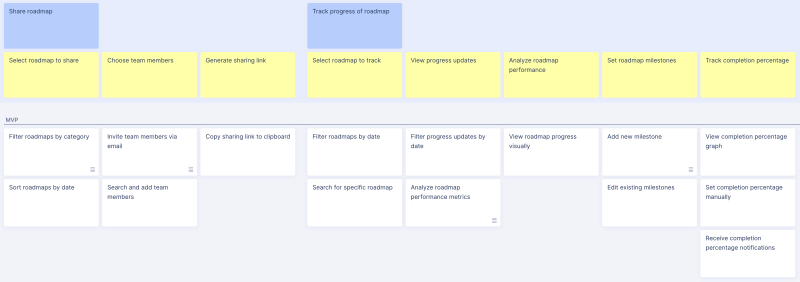Story mapper skillfully organizes and manages a product backlog using a user story map. A story mapper ensures that product development stays aligned with user needs, helping teams prioritize work effectively and plan successful releases. To become a pro story mapper, you first need to understand what story mapping is and why it plays a crucial role in Agile product development.
What is a story mapper and why does it matter?
A story mapper is more than just a backlog manager—it’s someone who visualizes the entire product journey, ensuring that every user story fits into a larger narrative. Instead of managing a flat, disconnected list of tasks, the user story map organizes work into a structured flow that reflects how users interact with the product. This approach helps teams focus on delivering value at every stage, making it easier to prioritize, plan, and iterate efficiently.
Who should use the user story map?
- Product Managers 🏗️ – Plan, prioritize, and communicate product vision clearly.
- Agile Teams 👨💻👩💻 – Break down work into manageable pieces for smooth sprints.
- UX Designers 🎨 – Map out user flows to create seamless experiences.
- Developers 🔧 – Understand the big picture and build the right features.
- Stakeholders 🤝 – Stay aligned on product goals and progress.
Why story mapping is important
A pro story mapper understands that a well-structured user story map is more than just a planning tool—it’s a roadmap for building the right product efficiently. By organizing user stories into a visual flow, a story mapper helps teams maintain clarity and direction throughout the development process. Here’s why story mapping is essential:
- Better Product Planning – A story mapper ensures the team aligns on what needs to be built first by structuring a user story map around user goals. This prevents teams from working on disconnected features and keeps the product vision clear.
- Improved Prioritization – Instead of drowning in a long, flat backlog, a story mapper organizes tasks in a way that highlights what truly matters. By mapping features against user journeys, focusing on the most impactful work becomes more manageable.
- Stronger Collaboration – A user story map encourages discussions between product managers, developers, designers, and stakeholders. A story mapper facilitates these conversations, ensuring everyone understands the workflow, dependencies, and priorities, leading to better decision-making and a more efficient development process.

Mastering story mapping, a story mapper can guide teams toward building products that meet real user needs while maintaining an organized and agile workflow.
Mastering the Basics of Story Mapping
To become a pro story mapper, you must structure a user story map effectively. A skilled story mapper doesn’t just list features—they organize work based on user needs, ensuring the team focuses on delivering real value. Here’s how to get started:
Define the target user persona
A story mapper begins by identifying who the product is for. Understanding the target user persona helps ensure the user story map reflects real user needs and behaviors. Consider factors like user roles, pain points, motivations, and expectations. The better you define your user, the more effective your story mapping will be.
Define goals
Every great product solves a problem. Before creating a user story map, a story mapper defines clear user and business goals. These goals help teams focus on the outcomes they want to achieve rather than just building features.
User journey (steps)
Once the target user and goals are defined, a story mapper maps out the key steps users take to accomplish their goals. This step-by-step structure forms the backbone of the user story map, providing a logical flow that guides product development.

Brainstorm user stories for each step 📌
A story mapper breaks down every step in the journey into specific user stories. These stories describe what users need at each stage, ensuring the development team builds the right functionality. A well-structured user story map turns high-level steps into actionable development tasks.
Prioritize user stories 🔝
Not all stories are equally important. A story mapper prioritizes user stories based on what’s essential for the product’s first version (MVP) versus what can be developed later. Must-have features are placed at the top of the user story map, while enhancements and lower-priority tasks go below. This structured approach helps teams stay focused and deliver value faster.
Following these steps, a story mapper ensures the product is built with a clear vision, structured workflow, and user-focused approach. 🚀
Advanced techniques for pro story mappers
Once you have mastered the basics, approaching the next level requires a deeper understanding of how to adapt and refine the user story map. These advanced techniques help ensure the process remains effective as the product evolves.
Focus on user needs
A strong user story map is built around real user behavior, not just a list of features. Instead of thinking in terms of what the team wants to build, focus on what the user actually needs at each step of their journey. This ensures that every story contributes to solving a real problem, improving engagement, and delivering meaningful value.
Use story mapping for MVP planning
An effective way to plan an MVP is by structuring the user story map to highlight the core functionality required for launch. Prioritizing the must-have user stories at the top allows teams to focus on delivering the most essential features first. This approach ensures a quicker time to market while keeping future enhancements in view for later iterations.
Keep the map flexible
A user story map is not a static document—it should evolve with the product and the team’s understanding of user needs. Regularly revisiting and adjusting the map based on feedback, testing, and changing priorities ensures that it remains a valuable guide throughout the development process. Flexibility allows teams to adapt without losing sight of the overall vision.
Concentrate on team needs
A well-structured user story map should support the team’s workflow and decision-making process. As priorities shift, update the structure, labels, and categories to keep the map relevant. Use clear and consistent labeling to improve navigation, ensuring each team member can quickly find and understand key sections.
Focus on shared understanding
A user story map is only effective if everyone on the team understands it. Take time to fine-tune and clarify the structure, ensuring that user stories, goals, and priorities are clearly communicated. Encourage discussions to align perspectives, resolve misunderstandings, and create a shared vision that guides development.
Organize story mapping workshops
Regular story mapping workshops help keep teams aligned and engaged in the process. These sessions provide an opportunity to review progress, refine the map, and ensure all stakeholders contribute their insights. Interactive workshops also foster collaboration, helping teams break down complex ideas and adjust priorities effectively.
Read best practices
Continuously improving as a story mapper means staying updated on best practices. Read case studies, explore expert recommendations, and learn from real-world examples of successful story mapping. Applying proven techniques helps refine your approach and ensures your user story map remains a powerful tool for guiding product development.
By incorporating these advanced techniques, a pro story mapper can enhance collaboration, streamline decision-making, and keep the product roadmap clear and actionable.
Useful resources
https://storiesonboard.com/product-management-resources.html
https://uxdesign.cc/how-to-user-story-mapping-workshop-448b58976ff
Tools that help you become a pro story mapper
Using the right tools can significantly improve the efficiency and effectiveness of story mapping. A well-designed tool allows teams to create, update, and collaborate on a user story map with ease. StoriesOnBoard is a leading platform explicitly built for story mapping, helping teams visually structure their product backlog, prioritize features, and align on the best course of action. With its intuitive interface and collaboration features, StoriesOnBoard makes it easy to organize user journeys, track development progress, and keep teams aligned throughout the product lifecycle.

Other tools, such as digital whiteboards and backlog management platforms, can support story mapping efforts, but dedicated story mapping tools provide the best experience by integrating directly with Agile workflows. Choosing the right tool ensures that your user story map remains clear, up-to-date, and actionable.
Start story mapping like a pro
Becoming a pro story mapper takes practice. The best way to improve is to start small, experiment with different approaches, and refine your process as you go. Focus on involving your team, gathering feedback, and continuously adjusting the user story map to reflect new insights.
Regularly reviewing and updating the story map ensures that it remains relevant and valuable throughout the development process. As you gain experience, you’ll develop a deeper understanding of how to structure your map effectively, prioritize work efficiently, and guide your team toward building successful products.
The more you use story mapping, the better you’ll get at it—so start mapping today and refine your skills with every project.
